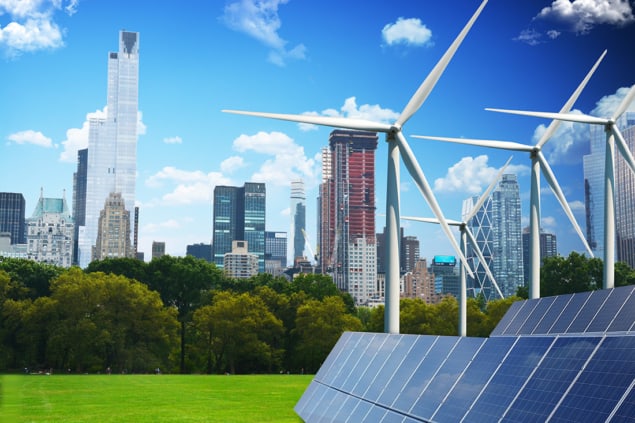Mark Jacobson and his team from Stanford reckon that 100% of all global energy can come from renewable sources (with biomass excluded) by 2050. Jacobson’s new 100% renewables model contains a new set of scenarios, which the researchers say confirms their view that it can be done – and with full grid balancing

Mark Jacobson and his team at Stanford University, US, got some flack for their 100% global renewable energy study last year. It said 139 countries around the world could obtain 100% of their energy from wind, water and solar (WWS) sources by 2050. It had been based on their 2015 study that examined the ability of 48 US states to meet all their energy needs stably from these renewables. Some said their approach was flawed, and, for example, relied too heavily on energy storage solutions and on adding turbines to existing hydroelectric dams to get extra power – see, for example, PNAS 114 6722.
In response, Jacobson and colleagues at Stanford, the University of California, Berkeley, and Aalborg University in Denmark, have now produced a new study focusing on 20 global regions encompassing the 139 countries, with supply and demand matching modelled for a range of storage/backup options over the period 2050–2054.
One scenario includes heat pumps, which are used in place of combustion-based heaters and coolers, but no hot- or cold-energy storage; two add no extra hydro turbines to what exists; and one has no battery storage. So they have options that reduce or avoid the contentious large extra hydro input and explore mixes of other options. Hydrogen from green sources is used for transport, but not otherwise. In their model test runs all the mixes worked, stably.
The team says that the fact that no blackouts occurred under the three different sample storage scenarios suggests that many possible solution mixes for grid stability with 100% wind, water and solar power are possible. They also found that the full final cost per unit of energy, in every scenario, was about one-quarter what it would be if the world continues on its current energy path. This is largely due to eliminating the health and climate costs of using fossil fuels. Also it was noted that, by reducing water vapour, the wind turbines in the mix would offset about 3% of global warming to date. The team’s explanation of this seems a bit convoluted, but the local air-speed changes created by wind turbines can precipitate water vapour, which is a powerful greenhouse gas (GHG). This saving is of course on top of much larger GHG saving from displacing fossil-fuel use – although it is pointed out that the latter will take time to show up in global temperature terms, whereas vapour reduction will have immediate local temperature impacts.
In addition to wind, solar cells and concentrated solar power (CSP) in some regions, are central in their proposed mix, as are marine renewables and geothermal – as in their earlier global and US scenarios. On the demand side, detailed heat and power loads are explored, including options for demand response, such as varying industrial high-temperature industrial-process loads and phased electric vehicle charging and flexible vehicle-to-grid storage capacity.
The team is confident that there would be no major problems with balancing. It notes that many previous studies had examined matching time-dependent demand with supply for up to 100% renewable electricity and some had looked at all-energy matching. All had found that “time-dependent supply can match demand at high penetrations of renewable energy without nuclear power, natural gas, or fossil fuels with carbon capture”.
But the team claims to have added even more certainty: in its new scenarios it says “100% of all end-use energy, rather than 100% of just electricity (which is ~20% of total end use energy), is decarbonized” with balancing solutions found “by considering many storage options, namely heat storage in rocks and water; cold storage in water and ice; electricity storage in CSP-storage, pumped hydropower, existing hydropower reservoirs, and batteries; and hydrogen storage; and by considering demand response and, in one scenario, heat pumps”.
Mark Delucchi of the University of California, Berkeley, and a co-author of the paper, says: “One of the biggest challenges facing energy systems based entirely on clean, zero-emission wind, water and solar power is to match supply and demand with near-perfect reliability at reasonable cost. Our work shows that this can be accomplished, in almost all countries of the world, with established technologies.” Jacobson was even more upbeat: “Based on these results, I can more confidently state that there is no technical or economic barrier to transitioning the entire world to 100% clean renewable energy with a stable electric grid at low cost.”
It will be interesting to see the reactions. It is certainly a detailed study and, interestingly, one that avoids the use of biomass and biofuels. However, producing scenarios for 2050–2054, using predictions of climate and weather patterns and energy use and supply, with full load balancing, is brave stuff. For the variable wind/solar outputs, produced at 30 second intervals, they use GATOR, a global weather-climate-air-pollution modelling tool (gas, aerosol, transport, radiation), combined with GCMOM (general circulation, mesoscale and ocean model), and then the LOADMATCH grid-integration model, providing tests for balancing of supply and demand using hourly demand data. But though computer modelling, using projected time-series data, can it seems do it all, even with sensitivity checks on modelled interactions, it is still a long way from reality – not least in terms of cost. No new technology is assumed, but, even so, identifying costs so far ahead introduces considerable uncertainty. Current capital cost/LCOE estimates from the literature are used, as in the previous studies, along with estimates for transmission costs and storage, which are all then fed into the model.
The approach used was to run the models multiple times with varying mixes to hone in on zero-load loss mixes and then to identify a low-cost mix of options – although not necessarily the lowest cost option, or the best in power terms, since their approach does not model power flows. While estimates for losses are included in the model, transmission is assumed to be unproblematic. Interestingly, one result of this, and also possibly of the exclusion of (storable) biomass, is that CSP with integral heat storage figures strongly in the list of low-cost balancing options. However, CSP is obviously location specific, and the options for longer distance grid-integration are also location sensitive.
The 20 regions used in the study were constituted “primarily on geographic proximity and some geo-political considerations”. In practice, however, it was accepted that “political opposition within the proposed regions is likely to result in some different groupings”. But since low-cost grid solutions under multiple wind, water and sunlight (WWS) configurations were found for all 20 regions spanning a wide range of geographic areas, resource availabilities, and demand conditions, it was felt that “increasing the number of regions or trading countries between regions should not inhibit the ability to obtain low-cost, stable solutions in other grid regions”. They add that “although the variability in solar and wind resources decreases when integrated over larger geographic areas, it is not possible to provide a general rule about the ‘optimal’ size of a grid-integration region. The optimum is determined by the tradeoff between the benefit of reducing temporal variability and the cost of expanding the grid. These benefits and costs vary dramatically with particular conditions in different countries”.
Even so, while some costs of energy may be higher, there will still be an overall cost saving from reduced energy use – due to improved energy efficiency in both end use and generation (with green electricity being used rather than inefficient combustion), better supply and demand matching (via smart grid and demand management) and savings on the cost of fossil fuel (with energy also no longer being needed for fossil fuel mining, extraction and transport). That means that the overall operational cost will be low. And if the social and environmental cost savings are added, it will be even lower.
As can be seen, no one optimal blueprint or pathway is offered. As the authors conclude, the possible solutions “are not limited to one 100% WWS pathway. Instead, multiple 100% WWS pathways with different mixes of generation, storage, and transmission, and demand response, are possible”. They may not all turn out to be available or attractive, but some surely need exploring. Although, as the modelling team says, that from their perspective there are no major problems with the options, the main challenge is the need to get consensus for action. In my next few posts, I will look at what’s actually happening around the world, starting with the EU and UK.



